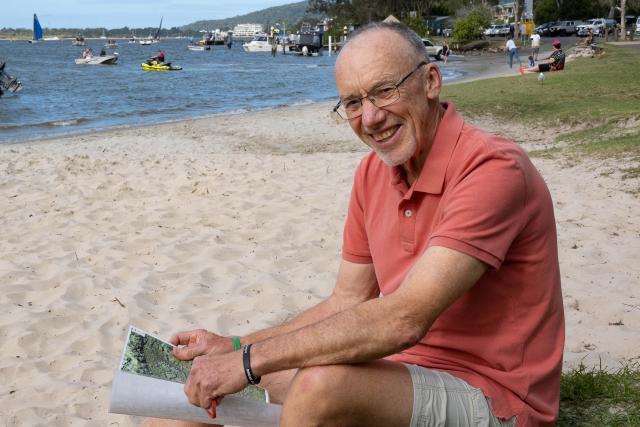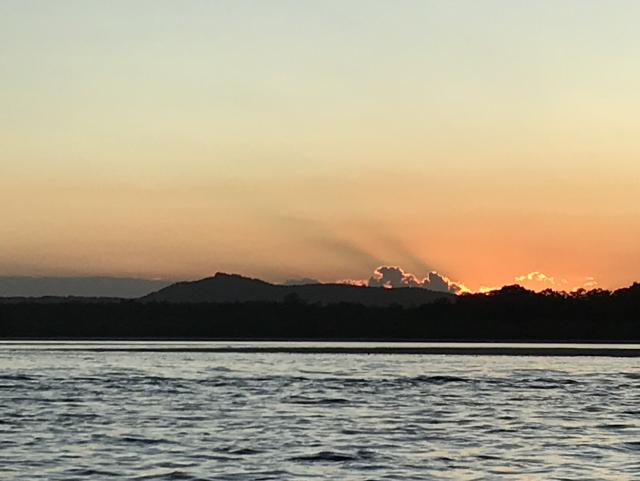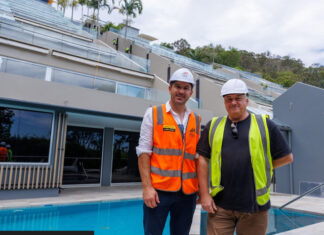Peter Hunnam may have retired after a 50-year career as an ecologist and environmental scientist, but he is certainly not the retiring type, and remains passionate about conserving and sustaining the natural world.
In fact, the 73-year-old Tewantin resident currently spends his spare time working to improve the ways we use and care for the Noosa River, which is the major objective of a report that he and associate Alex Western have just released.
“A subtle wake-up call,” is Peter’s description, which perhaps understates his conviction to build a brighter future for our estuary, which he regards as the vital but damaged heart of the Noosa region and Biosphere Reserve.
The ecologists’ report, Wetlands In Noosa River Estuary – Assessment of Urban Land-Use Pressures, is the initial stage of the Getting Our Wetlands project, prepared with the support of Noosa Integrated Catchment Association (NICA) and OzFish Noosa. It aims to provide a fresh perspective on the special nature of Noosa River estuary and the management and conservation issues that need to be addressed.
Peter explained the rationale to Noosa Today.
“The best way to conserve the Noosa River is to work out what and where the problems are and address them directly.
“Our survey adds to the ample information available on what needs to be done to adequately protect and sustainably use the Noosa River. The work strongly complements the major initiatives to Keep it in Kin Kin upstream and Bring Back the Fish downstream.
“All are parts of building a coherent eco-based management system to do what’s needed for the long-term health and amenity of our special river and its catchment.”
Peter and Alex used existing mapping data and ground-truthing to survey the whole estuary from Cooroibah to Weyba and across Tewantin, Noosaville, Noosa Heads and North Shore. They identified and mapped the main pressures on the estuary’s ecology from urban development and land-use in the catchment and along the shoreline and creeks.
“We have mapped the main types of pressure from urban land-use, including buildings, roads, drains, jetties and other infrastructure, which can damage the ecosystem by a combination of direct habitat destruction, edge encroachments and increased inputs, and altered water flows,” Peter said.
Some surprising findings were the extent of the lower Noosa River and its catchment. The riparian land area is over 9000 hectares, draining by only a small number of significant creeks into the main estuary channel. Not counting Lake Cooroibah and Lake Weyba, the central estuary has over 900 hectares of tidal waterways, which extend along a remarkable 66 kilometres of estuary foreshore and wetlands.
The central estuary is also the most urbanised section of the whole river system.
The survey found that urban development extended over 1400 hectares (around 38 per cent) of the riparian catchment and directly onto large sections of the estuary’s foreshore, replacing natural habitat with roads, parks, buildings and other foreshore and river infrastructure.
The most significant findings include the extent of edge encroachment by urban land-use – public and private properties and infrastructure – along 41 kilometres (62 per cent) of the tidal foreshore, and that all of Noosa’s urban run-off, carrying the sediment, litter and contaminants from every property, road and hard surface, is discharged through storm drains directly into the estuary wetlands and waterways.
In the ecologists’ view, the extensive encroachment and unregulated, untreated urban run-off are like permanent weeping sores into the estuary’s wetlands and waterways, continually degrading and damaging ecological health and biodiversity as well as the amenity for all users.
“Alex has done a great job digging out existing spatial data on the way in which Noosa’s residential, tourism and commercial centres have been developed closely around the estuary,” Peter said.
“The report is definitely a wake-up call, but a constructive one. It is clear from the assessment that urban Noosa has been developed without sufficient regard for the underlying ecosystem and its vital functions but there are opportunities to control the damaging effects of the main land-use pressures, and to restore degraded sections.
“It will be important to foster a different attitude and concerted effort by community and Council.
“It is notable how little has been done to limit these pressures from intensive urban development damaging the ecological functions and health of the estuary.
“The survey is only a preliminary broadscale assessment, but indicates that current management efforts are inadequate to sustain the natural values of the estuary.
“Much more needs to be done to reduce the main sources of degradation and restore the damaged ecology. We should be enhancing natural resilience instead of progressively weakening the ecosystem.”
The two ecologists and the community conservation groups they work with would like to see greater awareness and care of the river and catchment, their vital ecological functions and how they sustain all of the estuary’s natural values on which our use and enjoyment of the river depend.
The survey findings and recommendations about improving management of urban land-use pressures in the estuary have been provided to and discussed with Noosa Council as the main authority for different aspects of land-use management, urban development and conservation across all the foreshore and riparian lands.
The Wetlands Pressures report will also be presented to the Noosa River Stakeholders Advisory Committee on 24 October, and a discussion of the findings and ways forward is scheduled to be held at the Noosa Parks Association Environment Centre in November.
Noosa Today will examine the findings and recommendations of the report in two weeks’ time.









